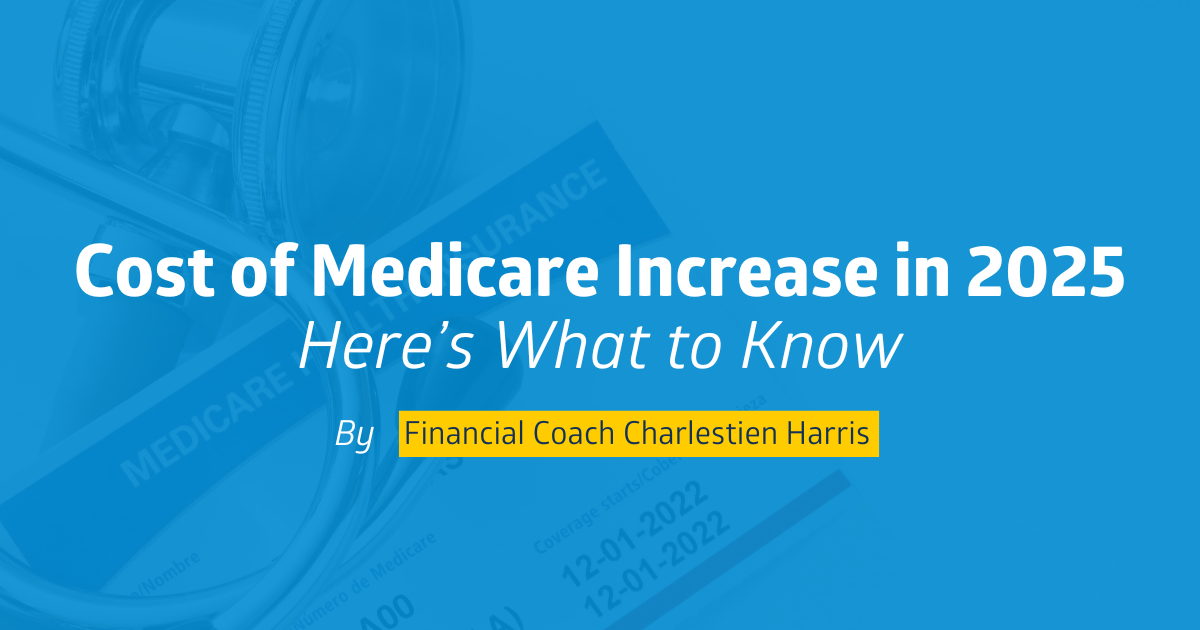By Charlestien Harris
I know, I know – nobody wants to hear about higher costs coming in the new year! But you should be prepared because the higher costs are coming regardless of whether you are prepared or not. For some seniors, this means making major adjustments to their monthly budget to make ends meet.
Cost increases are a fact of life, and Medicare raising its prices is no different. The best way to get ready for a change is to anticipate its coming and prepare for the increase or possible strain on your budget. After 62, you should expect more and more of your budget to go towards medical bills if you know you have health issues. Let’s take a look at some of the increases you might incur if you depend on Medicare as a primary source of payment for your medical bills.
- Premiums (Medicare Part A – Hospital Insurance) Costs
There are some costs that any Medicare beneficiary faces. In 2025, the Part B premium will be $185, an increase of $10.30 from this year and $20.10 more than in 2023. Most people don’t pay a Part A premium because they paid Medicare taxes while working. If you don’t get premium-free Part A, you could pay up to $518 each month. If you don’t buy Part A when you’re first eligible for Medicare (usually when you turn 65), you might pay a penalty. - Deductibles (Medicare Part B – Medical Insurance) Costs
The annual deductible for Part B will be $257 in 2025, which is $17 more than in 2024. In 2025, the Part B deductible of $257 must be met before Original Medicare starts to pay. You only pay this deductible once each year. The Social Security Administration will tell you the exact amount you’ll pay for Part B in 2025. If your modified adjusted gross income, as reported on your IRS tax return from two years ago, is above a certain amount, you’ll pay the standard Part B premium and an income-related monthly adjustment amount. - Medicare Advantage Plans (Part C) Premiums
A Medicare Advantage Plan (like an HMO or PPO) is another Medicare health plan choice you may have as part of Medicare. Medicare Advantage Plans, sometimes called “Part C” or “MA Plans,” are offered by private companies approved by Medicare. If you join a Medicare Advantage Plan, the plan will provide all of your Part A (Hospital Insurance) and Part B (Medical Insurance) coverage. Medicare Advantage Plans may offer extra coverage, such as vision, hearing, dental, and/or health and wellness programs. Most include Medicare prescription drug coverage (Part D). Medicare pays a fixed amount for your care every month to the companies offering Medicare Advantage Plans. These companies must follow rules set by Medicare. However, each Medicare Advantage Plan can charge different out-of-pocket costs and have different rules for how you get services (like whether you need a referral to see a specialist or if you have to go to only doctors, facilities, or suppliers that belong to the plan for non-emergency or non-urgent care). These rules can change each year. Visit Medicare.gov/plan-compare to find and compare plan premiums. You can also call 1-800-MEDICARE (1-800-633-4227). TTY users can call 1-877-486-2048. - Part D National Base Premium
In 2025, the national base premium will be $46.50. Part D plan members will also enjoy the security of an annual maximum out-of-pocket cost for prescription drugs. Beginning January 1, 2025, people with Part D plans through traditional Medicare and Medicare Advantage plans with prescription drug coverage won’t pay more than $2,000 over the calendar year in out-of-pocket costs for their prescription medications. Medicare uses the national base premium to estimate the Part D late enrollment penalty and the income-related monthly adjustment amounts listed in a precalculated table you can find at Medicare Costs. The national base amount can change each year. If you pay a late enrollment penalty, your total premium amount may be higher. In 2025, the Medicare Part D coverage gap, also known as the “donut hole,” will be eliminated under the Inflation Reduction Act (IRA). - Part D Drug Plan Payment Option
Beginning in 2025, Medicare prescription drug plans must offer enrollees the option to spread their out-of-pocket prescription drug costs into monthly payments throughout the year, instead of paying them all at once at the pharmacy. If you choose to opt into the Medicare Prescription Payment Plan, you’ll receive a bill from your Medicare Advantage or standalone Part D plan for your drug costs instead of paying at the pharmacy. There’s no extra cost to participate in the program. To sign up or learn more, contact your Medicare prescription plan provider.
As you can see, there are big changes coming to Medicare in 2025, and they could make a major difference in your prescription drug costs and other parts of your Medicare insurance. Thanks to the Inflation Reduction Act, Medicare beneficiaries will see the most significant updates to the program’s drug coverage since it was first introduced in 2006. Try to do your due diligence when it comes to choosing your Medicare coverage to make sure it will cover exactly what you need it to cover, and you can plan for those cost increases that you now know are coming!
For more information about this and other financial topics, you can email me at Charlestien.Harris@banksouthern.com or call me at 662-624-5776.
Until next week – stay financially fit!
